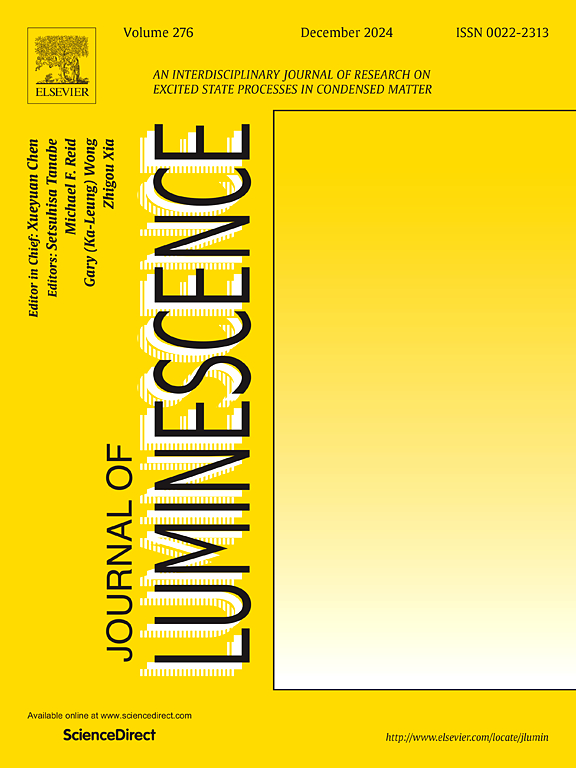975 nm上转换发射激发LaInO3:Er3+的光学温度传感
IF 3.3
3区 物理与天体物理
Q2 OPTICS
引用次数: 0
摘要
本文报道了Er3+离子掺杂LaInO3的发光特性,用于温度检测和测量。采用Pechini溶胶-凝胶法合成样品,获得纯净,均匀的材料,具有不确定的形态,凝聚形成微球。在975 nm处激发,在527、542和675 nm处获得了上转换,这是由于两个光子的吸收和能量转移机制产生的。利用发光强度比技术研究了297 ~ 327 K范围内温度对527 ~ 542 nm发射比(即热耦合能级)的影响。获得了绝对灵敏度、相对灵敏度和不确定度等测温参数,评价了该材料在发光测温中的应用。最大灵敏度和相对灵敏度分别为6.18 × 10−3% K−1 (417 K)和1.05% K−1 (297 K),不确定度分别为0.07 K和0.15 K (417 K)。由于样品的强烈发射,不确定度值非常好,导致非常高的信噪比。本文章由计算机程序翻译,如有差异,请以英文原文为准。
Optical temperature sensing in LaInO3:Er3+ by up-conversion emission exciting at 975 nm
This work reports the luminescent properties of Er3+ ion-doped LaInO3 for temperature detection and measurement. The samples were synthesized using the Pechini sol-gel method, obtaining pure, homogeneous materials with non-defined morphology that agglomerate forming microspheres. Exciting at 975 nm, up-conversion was obtained with emission bands centered at 527, 542 and 675 nm, which are generated due to the absorption of two photons and an energy transfer mechanism. The ratio between 527 and 542 nm emissions, well known thermally coupled levels, was studied as a function of temperature in the range between 297 and 327 K using the luminescence intensity ratio technique. The thermometric parameters of absolute sensitivity, relative sensitivity, and uncertainty were obtained to evaluate the material's application in luminescent thermometry. The maximum sensitivity and relative sensitivity values found were 6.18 x 10−3 % K−1 at 417 K and 1.05 % K−1 at 297 K, while the uncertainty found was 0.07 K at 297 K and 0.15 K at 417 K. The uncertainty values are excellent due to the intense emission of the samples, leading to a very high signal/noise ratio.
求助全文
通过发布文献求助,成功后即可免费获取论文全文。
去求助
来源期刊

Journal of Luminescence
物理-光学
CiteScore
6.70
自引率
13.90%
发文量
850
审稿时长
3.8 months
期刊介绍:
The purpose of the Journal of Luminescence is to provide a means of communication between scientists in different disciplines who share a common interest in the electronic excited states of molecular, ionic and covalent systems, whether crystalline, amorphous, or liquid.
We invite original papers and reviews on such subjects as: exciton and polariton dynamics, dynamics of localized excited states, energy and charge transport in ordered and disordered systems, radiative and non-radiative recombination, relaxation processes, vibronic interactions in electronic excited states, photochemistry in condensed systems, excited state resonance, double resonance, spin dynamics, selective excitation spectroscopy, hole burning, coherent processes in excited states, (e.g. coherent optical transients, photon echoes, transient gratings), multiphoton processes, optical bistability, photochromism, and new techniques for the study of excited states. This list is not intended to be exhaustive. Papers in the traditional areas of optical spectroscopy (absorption, MCD, luminescence, Raman scattering) are welcome. Papers on applications (phosphors, scintillators, electro- and cathodo-luminescence, radiography, bioimaging, solar energy, energy conversion, etc.) are also welcome if they present results of scientific, rather than only technological interest. However, papers containing purely theoretical results, not related to phenomena in the excited states, as well as papers using luminescence spectroscopy to perform routine analytical chemistry or biochemistry procedures, are outside the scope of the journal. Some exceptions will be possible at the discretion of the editors.
 求助内容:
求助内容: 应助结果提醒方式:
应助结果提醒方式:


